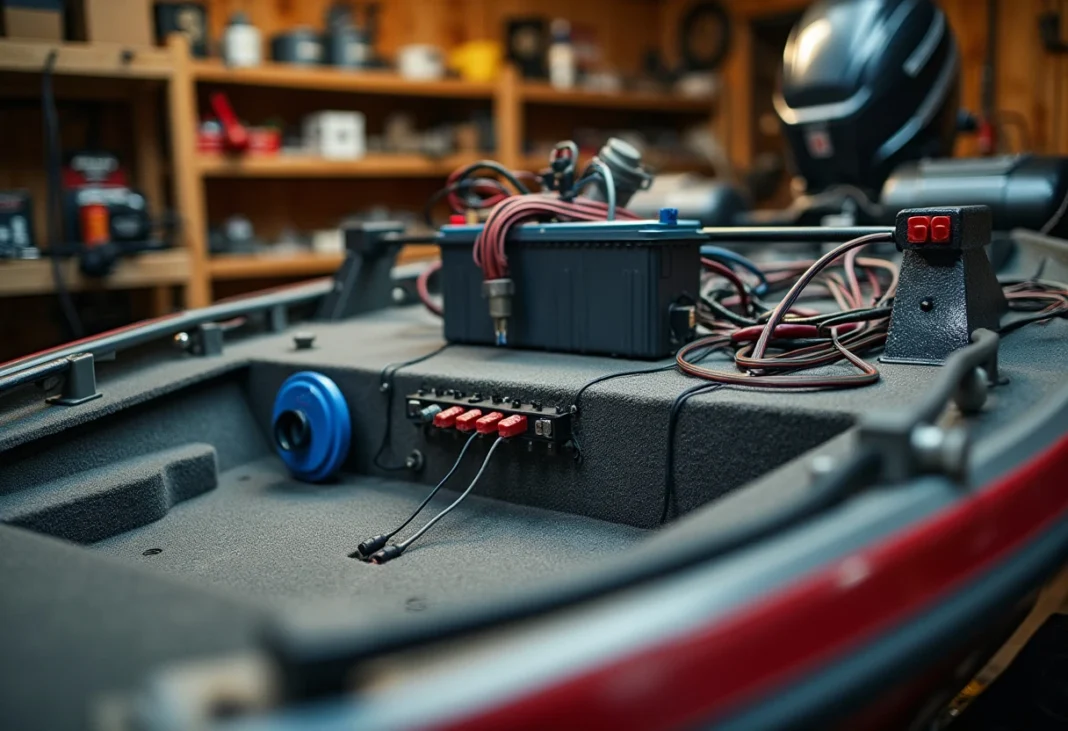Bass Boat Rewiring
Proper wiring is essential for the safe and efficient operation of your bass boat. Over time, wiring can become corroded, damaged, or outdated, leading to potential safety hazards and decreased performance. Rewiring your bass boat is a comprehensive process that requires careful planning, organization, and attention to detail. In this guide, we will walk you through the process of rewiring your bass boat from start to finish.
Importance of Proper Wiring
Proper wiring ensures that all electrical components in your bass boat function correctly and safely. Faulty wiring can lead to misfires, blown fuses, and potentially dangerous situations. Additionally, proper wiring can prevent electrical interference, which can cause malfunctions in other electronic devices onboard
Assessing When to Rewire Your Bass Boat
If you’ve noticed any symptoms such as intermittent electrical issues, burnt or frayed wires, or outdated wiring components, then it may be time to consider a rewiring project. A routine inspection of your wiring should be conducted periodically, and any damage or signs of wear and tear should be addressed promptly.
Safety Concerns and Precautions
Before embarking on a rewiring project, it’s essential to take necessary safety precautions. Disconnect all electrical systems and devices, wear appropriate protective gear, and ensure that the boat’s power supply is completely turned off. Additionally, it’s critical to follow all manufacturer instructions and consult with a professional if uncertain about any aspect of the project.
Planning Your Rewiring Project
Before diving into the rewiring process, it’s important to have a solid plan in place. This will help ensure that the project runs smoothly and that all necessary components are accounted for. Here are some key steps to follow when planning your bass boat rewiring project:
Creating a Wiring Diagram for Your Bass Boat
One of the first things you should do when planning your rewiring project is to create a detailed wiring diagram for your bass boat. This will help you visualize the entire electrical system and identify any potential issues or areas that require special attention. Your wiring diagram should include all components, such as batteries, fuse blocks, switch panels, and lights, as well as the wiring connections between them.
List of Materials and Tools Needed
Once you have your wiring diagram in hand, make a list of all the materials and tools you’ll need to complete the project. This may include items such as marine-grade wiring, connectors, heat shrink tubing, electrical tape, crimping tools, wire strippers, and a multimeter. Make sure to purchase high-quality materials that are designed specifically for use in marine environments.
Choosing the Right Type of Marine Wiring and Connectors
When selecting your wiring and connectors, it’s important to choose products that are specifically designed for marine use. This will help ensure that they can withstand the unique challenges of a wet, corrosive environment. Look for wiring and connectors that are labeled as “marine-grade” or “water-resistant,” and choose products with a high copper strand count, which will help ensure good conductivity.
Setting a Timeline and Budget for the Rewiring Process
Finally, it’s important to set a realistic timeline and budget for your rewiring project. Depending on the size of your boat and the complexity of the electrical system, this may be a multi-day or even multi-week project. Make sure to account for all necessary materials and tools, as well as any labor costs if you plan to hire a professional. By setting a clear timeline and budget from the outset, you’ll be better equipped to manage the project and avoid any unexpected expenses or delays.
Removing Old Wiring and Components
Before starting with the rewiring process, it is important to disconnect the old wiring and remove outdated or damaged equipment efficiently and safely. Here are some steps to follow:
- Step 1: Turn off all power sources – Before attempting to disconnect anything, ensure that all power sources are turned off or disconnected. This will prevent the risk of electric shock or short-circuits.
- Step 2: Remove battery connections – Disconnect the battery and remove all terminals from the battery cables. Cover the cable ends with electrical tape to prevent accidental contact.
- Step 3: Label and organize old wiring – Take a moment to label all wires that are being removed. This will help in the reassembly process. You can use colored electrical tape to make it easier to identify individual wires. Organize these wires in a manner that they don’t get tangled during the process.
- Step 4: Remove outdated or damaged equipment – This includes all switches, gauges, and any other electrical equipment that needs to be replaced or repaired. Take the help of proper tools such as screwdrivers and pliers to remove these components.
- Step 5: Detach wiring – Unscrew all wires from the component they are connected to and remove them carefully. Ensure that you take note of all the components to be reinstalled, including switches and gauges, and their individual wiring requirements.
Proper labeling and organization during the removal process will ensure that the rewiring process is smoother and efficient. Store removed components and dispose of old or damaged components that are no longer required properly.
Installing New Marine Electrical Systems
Now that you have removed the old wiring and components from your bass boat, it is time to install the new marine electrical systems. Follow these steps to ensure a smooth and safe installation process.
Step-by-Step Guide to Running New Wiring
Running new wiring is one of the most important steps in the rewiring process. Properly run wiring will ensure functional and safe electrical systems in your bass boat. Follow these steps to run new wiring:
- Start by identifying the routes where the new wiring will run.
- Gather all necessary tools and materials for the wiring installation.
- Use zip ties and clips to secure the wiring to the boat to prevent it from rubbing or chafing against other components.
- Be sure to follow the color codes of the wires and connect them as per your wiring diagram.
- Test the wiring to ensure it functions properly before securing it permanently to the boat.
Installing Essential Components such as Batteries, Fuse Blocks and Switch Panels
Along with the new wiring, it is important to install essential components such as batteries, fuse blocks, and switch panels. These components will be responsible for controlling the marine electrical systems in your bass boat. Follow these steps to install essential components:
- Install fuse blocks and switch panels in a location that is both easily accessible and safe.
- Install batteries in a ventilated area and ensure they are secure to prevent damage from shifting or movement.
- Connect the batteries correctly, following the color codes of the wiring.
- Test the essential components to ensure they function properly before securing them permanently to the boat.
Best Practices for Waterproofing and Protecting Electrical Connections
Marine electrical systems are exposed to the elements and water, which can lead to corrosion and other damage. To protect your investment and prolong the life of your marine electrical systems, follow these best practices for waterproofing and protecting electrical connections:
- Use marine-grade sealant around connections and components to prevent water from entering and causing damage.
- Use marine-grade heat shrink tubing to protect and seal connections.
- Use silicone grease on battery terminals to prevent corrosion.
- Regularly inspect and maintain your marine electrical systems to ensure they function properly and are protected from damage.
Following these steps will help ensure a safe and functional marine electrical system in your bass boat.
| Steps | Key Data Points |
|---|---|
| Running new wiring |
|
| Installing essential components |
|
| Waterproofing and protecting electrical connections |
|
Testing and Troubleshooting
Now that you have completed rewiring your bass boat, it is time to test and troubleshoot any issues that may arise. Proper testing and troubleshooting are vital to ensure the safety and functionality of your rewiring project.
Testing Your Rewiring for Functionality and Safety
Firstly, it is important to test the complete functionality and safety of your rewiring project. Turn on your electrical system and ensure that all your components are working correctly. Ensure that there are no fire hazards and that all the wires are correctly connected to the right components. You can test the battery voltage and ensure that your switches and fuses operate as desired.
It is also essential to test the durability of the components and wiring by exposing them to harsh marine conditions. Try immersing the wiring in water and check that the waterproofing measures are sufficient, and there are no leakages. The connectors should firmly hold the wires, and there should be no loose connections.
Common Issues and How to Troubleshoot Them
Even with proper planning, there might still be issues that may arise after rewiring your bass boat. Here are some common issues and their remedies:
- Dead battery: If you experience a dead battery, check the connections and fuses to ensure that they are not the problem. Check that your battery is correctly charged and that your alternator and charging system are working correctly.
- Electrical short circuits: Electrical circuit breakers protect boats from electrical overload and short circuits. If you encounter any short circuits, check that the circuit breakers are functioning correctly and replace any fuse that is damaged.
- Electrical interference: If you experience any electrical interference, it might be due to a poorly grounded electrical system. Try checking all the connections again and ensure that they are correctly connected and grounded.
Final Inspection and Maintenance Tips
After ensuring that your rewiring project is working correctly, it would be helpful to conduct a final inspection to ensure that everything is correctly connected and in place. Proper inspection involves going over all the wiring and connection points, and checking the security of the wires and components.
Maintenance is essential to keep your electrical system working well. You should routinely check that your electrical system is functioning correctly and check for any visual issues. Ensure that all the connections are functioning well and maintain proper battery voltage. Regular maintenance will help to extend the longevity of your rewiring project.
Frequently Asked Questions
Q: Can I rewire my bass boat myself?
A: Yes, rewiring your bass boat is possible. However, rewiring a bass boat involves technical knowledge and expertise. It requires proper planning, the right tools, and knowledge of electrical systems. It is essential to follow safety precautions to avoid fire hazards and electrocution. If you are not confident of your skills, it is recommended to hire a professional.
Q: How much does it cost to rewire a bass boat?
A: The cost of rewiring a bass boat depends on various factors such as the boat’s size, the complexity of the installation, the components used, and the cost of labor. The cost of materials can range from $500 to $1500, while labor can range from $1500 to $5000.
Q: How long does it take to rewire a bass boat?
A: The time it takes to rewire a bass boat depends on the complexity of the installation, the boat’s size, and the extent of the electrical system. A simple installation can take a few days, while more complex installations that require the removal of old wiring components can take up to a week.






